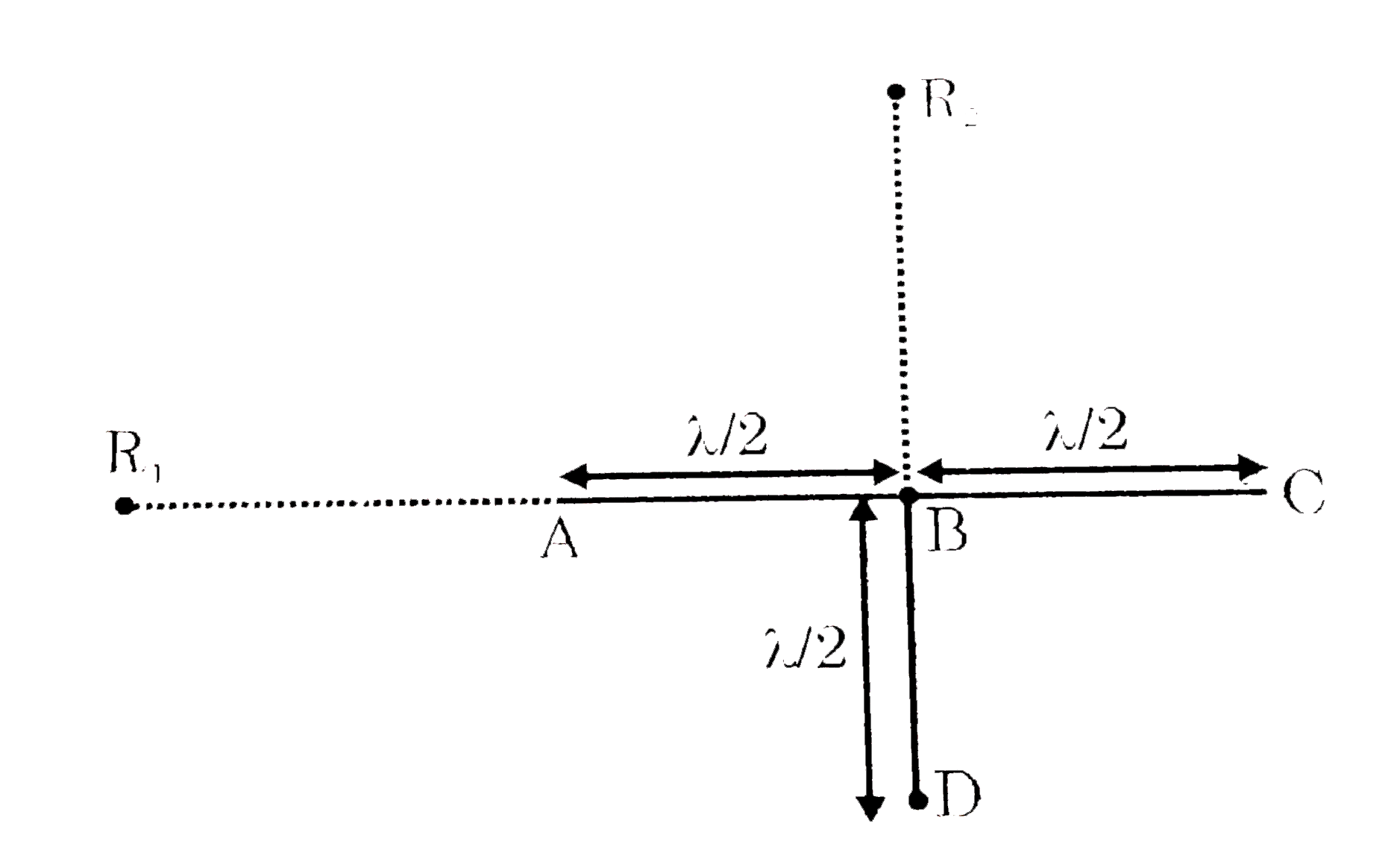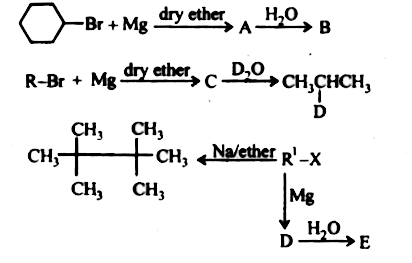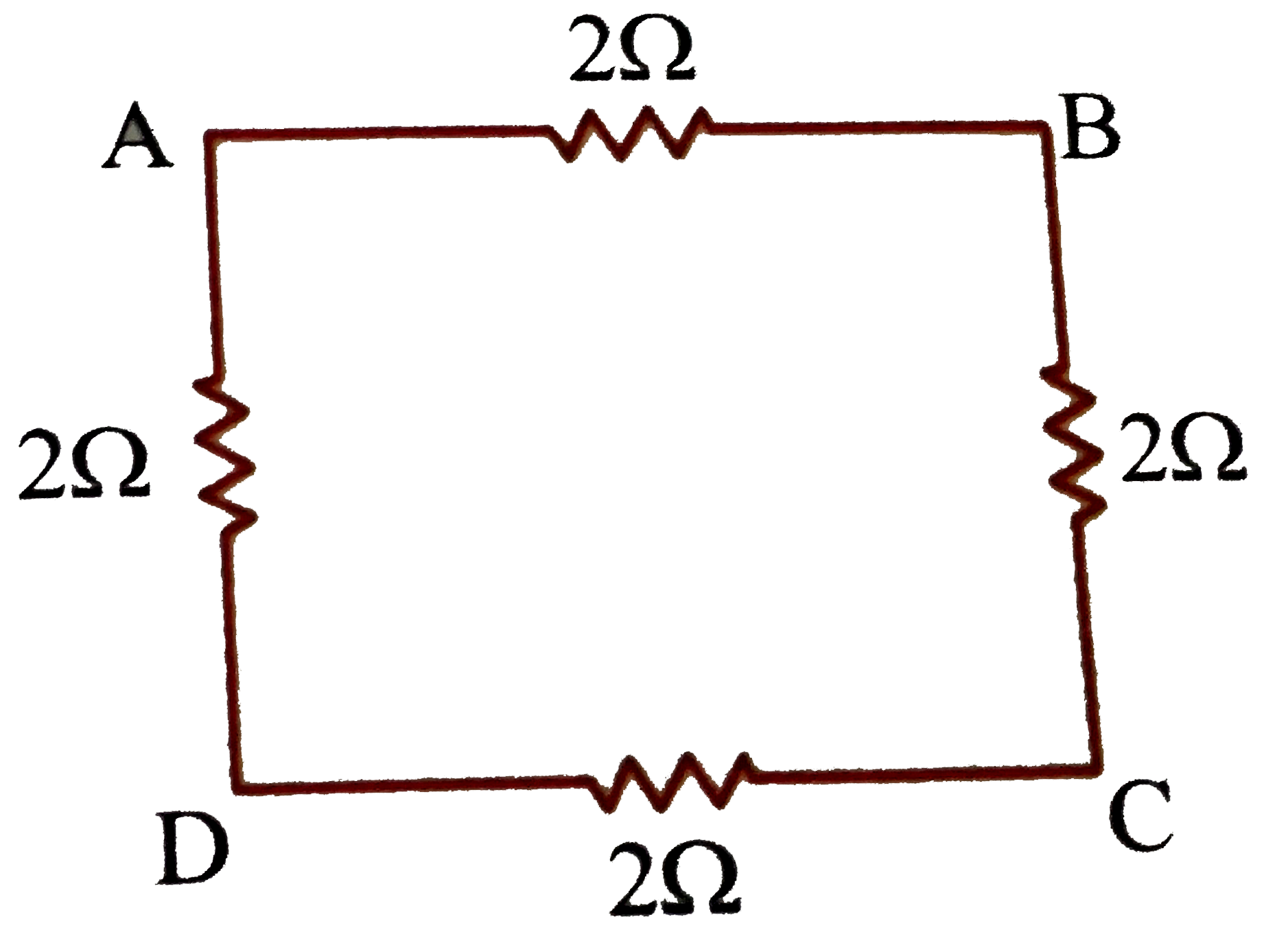Four identical coherent sourc e emiting monochromatic light if same wavelength lambda are placed at A,B,C and D as shown. Two receivers R1 and R2 are at but equal distance from B. The path difference between signals reaching from A&D at R1 is λ2 and between signals reaching from A & B at R2is≅0. Also assume that intensities of waves emitted by A,B,C &D reaching at R1 and R2 is same.

R1records greater intensity if all the sources are on.
R1andR2 records same intensity if B is switched of, and other sources are on.
R2 records greater intensityif D switched off, and other sources are on.
It is possible to know, whether B is switch off or D is switched off by recording intensities at R1 and R2
The correct Answer is:B, C, D
At R2
ΔQBA=QBC=0
ΔQBD=π
AtR1
ΔQBA=π
QAD=π
ΔQBC=π
(A) When all sources are on at R1
I=0
at R2,
I∝4a2
(where a is amptitude of individual waves reaching at R1 &R2)
(B) When only B is switched off
IR1∝a2
IR2
When only D is switched off
IR1∝a2
IR2∝9a2
(D) By measuring intensities it is possible to know, which source out of B&D is switched off.
Topper's Solved these Questions
- TEST PAPERSBOOK - ALLENCHAPTER - TEST PAPERSEXERCISE - part-2 physics
63 Videos
- TEST PAPERSBOOK - ALLENCHAPTER - TEST PAPERSEXERCISE - part-2 physic
48 Videos
- TEST PAPERSBOOK - ALLENCHAPTER - TEST PAPERSEXERCISE - PAPER 3
100 Videos
- TEST PAPER 4BOOK - ALLENCHAPTER - TEST PAPER 4EXERCISE - PHYSICS
45 Videos
- UNIT & DIMENSIONS, BASIC MATHS AND VECTOR BOOK - ALLENCHAPTER - UNIT & DIMENSIONS, BASIC MATHS AND VECTOR EXERCISE - Exercise (J-A)
7 Videos
Similar Questions
Four identical monochromatic sources A,B,C,D as shown in the (figure) produce waves of the same wavelength λ and are coherent. Two receiver R1 and R2 are at great but equal distances from B.
(i) Which of the two receivers picks up the larger signal when B is turned off?
(iii) Which of the two receivers picks up the larger singnal when D is turned off ?
(iv) Which of the two receivers can distinguish which of the sources B or D has been turned off ?

View SolutionFour identical resistances are joined as shown in the figure. The equivalent resistance between points A and B is R1 and that between A anc C is R2 then ratio R1/R2 is

View Solution
Knowledge Check
Four identical monochromatic source A, B, C, D as shown in figure produce waves of the same wavelength λ and are coherent. Two receivers R1 and R2 are at great but equal distance from B. The choose the correct statements.
 Athe reciver R2 picks up the larger singalBtwo receiver R! and R2 picks up singals of equal intensity when B is turned offCwhen source D is turned off R2 picksup larger singalDwhen source B is turned off the singal recevied by R1 changes
Athe reciver R2 picks up the larger singalBtwo receiver R! and R2 picks up singals of equal intensity when B is turned offCwhen source D is turned off R2 picksup larger singalDwhen source B is turned off the singal recevied by R1 changesSix resistances each of v ale r=6Ω are connected between points A,B and C as shown in the figure if R1,R2 and R3 are the net resistances between A and B, between B and C and between A and C respectively, the R1:R2:R3 will be equal to
 A6:3:2B1:2:3C5:4:3D4:3:2
A6:3:2B1:2:3C5:4:3D4:3:2Six resistance each of value r=5Ω are connected between points A, B and C as shown in figure. If R1,R2 and R3 are the net resistance between A and B, between B and C and between A and C respectively, then R1:R2:R3 will be equal to
 A6:3:2B1:2:3C5:4:3D4:3:2
A6:3:2B1:2:3C5:4:3D4:3:2
Two coherent point source S1 and S2 vibrating in phase emit light of wavelength λ. The separation between them is 2λ as shown in figure. The first bright fringe is formed at 'P' due to interference on a screen placed at distance 'D' from S1(D>>λ), then OP is

1) √3D,2)1.5D,3)√2D,4)2D
View SolutionIn the circuit as shown in figure,
E1=2V,E2=2V,E3=1V,andR=r1=r2=r3Ω.
The potential difference between points A and B will be

View SolutionIdentify A, B, C, D, E, R and R1 in the following:

View SolutionFour identical resistance are joined as shown in fig. the equivalent resistance between points A and B is R1 and that between A and C is R2. Then ratio of R1R2 is

View SolutionAmong the two interfering monochromatic sources A and B, A is ahead of B in phase by 66∘. If the observation be taken from point P, such that PB−PA=λ/4. Then the phase difference between the waves from A and B reaching P is
View Solution
